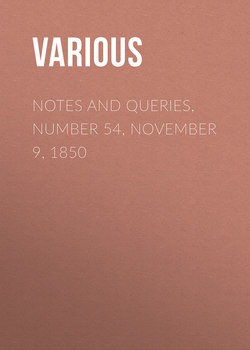Читать книгу Notes and Queries, Number 54, November 9, 1850 - Various - Страница 3
Notes
MASTER JOHN SHORNE
ОглавлениеIf proof were wanted how little is now known of those saints whose names were once in everybody's mouth, although they never figured in any calendar, it might be found in the fact that my friend, Mr. Payne Collier, whose intimate knowledge of the phrases and allusions scattered through our early writers is so well known and admitted, should, in his valuable Extracts from the Registers of the Stationers' Company (1557-1570), have illustrated this entry,—
"1569-70. Rd. of Thomas Colwell, for his lycense for the pryntinge of a ballett intituled 'Newes to Northumberlande yt skylles not where, to Syr John Shorne, a churche rebell there' … iiijd."
by a note, from which the following is an extract:—
"Sir John Shorne no doubt is to be taken as a generic name for a shaven Roman Catholic priest."
Reasonable, however, as is Mr. Collier's conjecture, it is not borne out by the facts of the case. The name Sir John Shorne is not a generic name, but the name of a personage frequently alluded to, but whose history is involved in considerable obscurity. Perhaps the following notes may be the means, by drawing forth others, of throwing some light upon it. In Michael Wodde's Dialogue, quoted by Brand, we read—
"If we were sycke of the pestylence we ran to Sainte Rooke; if of the ague, to Sainte Pernel or Master John Shorne."
Latimer, in his Second Sermon preached in Lincolnshire, p. 475. (Parker Society ed.), says,—
"But ye shall not think that I will speak of the popish pilgrimages, which we were wont to use in times past, in running hither and thither to Mr. John Shorn or to our Lady of Walsingham."
On which the editor, the Rev. G. E. Corrie, remarks that he was—
"A saint whose head quarters were probably in the parish of Shorn and Merston near Gravesend, but who seems to have had shrines in other parts of the country. He was chiefly popular with persons who suffered from ague."
Mr. Corrie then gives an extract from p. 218. of the Letters relating to the Suppression of Monasteries, edited by Mr. Wright for the Camden Society; but we quote from the original, Mr. Corrie having omitted the words given in our extract in Italics:—
"At Merston, Mr. Johan Schorn stondith blessing a bote, whereunto they do say he conveyd the devill. He ys moch sowzt for the agou. If it be your lordeschips pleasur, I schall sett that botyd ymage in a nother place, and so do wyth other in other parties wher lyke seeking ys."
In that extraordinary poem The Fantassie of Idolatrie, printed by Fox in his edition of 1563, but not afterwards reprinted until it appeared in Seeley's edition (vol. v. p. 406.), we read—
"To Maister John Shorne
That blessed man borne;
For the ague to him we apply,
Whiche jugeleth with a bote
I beschrewe his herte rote
That will truste him, and it be I."
The editor, Mr. Cattley, having explained bote "a recompense or fee," Dr. Maitland, in his Remarks on Rev. S. R. Cattley's Defence of his Edition of Fox's Martyrology, p. 46., after making a reference to Nares, and quoting his explanation, proceeds:
"The going on pilgrimage to St. John Shorne is incidentally mentioned at pages 232. and 580. of the FOURTH volume of Fox, but in a way which throws no light on the subject. The verse which I have quoted seems as if there was some relic which was supposed to cure the ague, and by which the juggle was carried on. Now another passage in this same fifth volume, p. 468., leads me to believe that this relic really was, and therefore the word 'bote' simply means, a boot. In this passage we learn, that one of the causes of Robert Testwood's troyble was his ridiculing the relics which were to be distributed to be borne by various persons in a procession upon a relic Sunday. St. George's dagger having been given to one Master Hake, Testwood said to Dr. Clifton,—'Sir, Master Hake hath St. George's dagger. Now if he had his horse, and St. Martin's cloak, and Master John Shorne's boots, with King Harry's spurs and his hat, he might ride when he list.'"
That there is some legend connected with Master John Shorne and "his bote, whereunto they do say he conveyd the devill," is evident from a fact we learn from the Proceedings of the Archæological Institute, namely, that at the meeting on the 5th Nov. 1847, the Rev. James Bulwer, of Aylsham, Norfolk, sent a series of drawings exhibiting the curious painted decorations of the rood screen in Cawston Church, Norfolk, amongst which appears the singular saintly personage bearing a boot, from which issues a demon. An inscription beneath the figures gives the name "Magister Johannes Schorn." It is much to be regretted that fuller details of this painting have not been preserved in the Journal of the Institute.
The earliest mention of Master John Schorne is in the indenture for roofing St. George's Chapel at Windsor, dated 5th June, 21 Henry VII. (1506), printed in the Reliquiæ Antiquæ, vol. ii. p. 115., where it is covenanted
"That the creastes, corses, beastes, above on the outsides of Maister John Shorne's Chappell, bee done and wrought according to the other creastes, and comprised within the said bargayne."
William J. Thoms.
